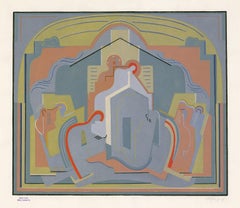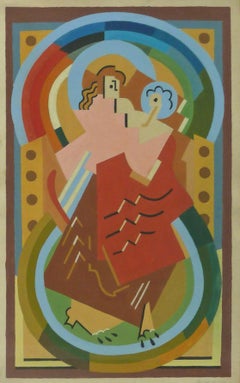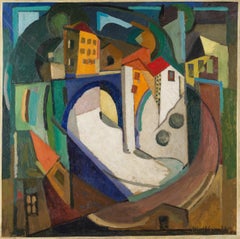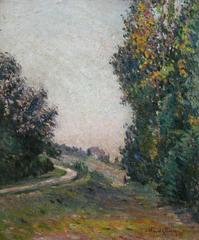Albert Gleizes Art
French, 1881-1953
Albert Gleizes (1881-1953) was a prominent French artist, theorist, and philosopher, best remembered as a pioneer of Cubism alongside artists like Picasso and Braque. Born in Paris, his early work was influenced by Impressionism, but by 1910, he had delved deep into the innovative world of Cubism, emphasizing geometrical forms and multiple viewpoints. With Jean Metzinger, he co-authored "On Cubism," a significant treatise that helped define and explain the movement's principles. Throughout his career, Gleizes continued to evolve his style, moving towards abstraction and integrating his fascination with rhythm and color. In addition to his visual contributions, his writings made him an influential voice in 20th-century art theory. A true visionary, Gleizes not only reshaped the art world with his creations but also laid the groundwork for future abstract artists with his profound insights into the essence of art.(Biography provided by IR Fine Art)
to
2
1
1
1
1
1
1
1
1
Overall Height
to
Overall Width
to
1
1
3
1
1
1
3
6,856
3,171
2,516
1,217
2
1
1
1
1
Artist: Albert Gleizes
'Descente de Croix' (Descent from the Cross) — 1920s French Cubism
By Albert Gleizes
Located in Myrtle Beach, SC
Albert Gleizes, 'Descente de Croix', color pochoir, 1928, edition c. 50. Signed and dated in pencil. A fine, painterly impression, with fresh colors, on heavy, cream wove paper; the full sheet with margins (3 to 4 inches), in very good condition. The publisher's ink stamp 'EDITIONS MOLY-SABATA' beneath the image, lower left. Matted to museum standards, unframed.
Image size 12 x 14 inches (305 x 356 mm); sheet size 18 x 22 inches (457 x 559 mm).
ABOUT THE IMAGE
After the 1927 painting 'Descente de Croix', one of three religious-themed works that Gleizes developed as preliminaries for murals at the church at Serrières, France, the project was terminated at its final phase, and Gleizes commissioned master printer Robert Pouyaud to create prints of the paintings, closely overseeing the production.
ABOUT THE MEDIUM
Pochoir is a refined stencil-based technique employed to create multiples or to add color to prints produced in other mediums. Characterized by its crisp lines and rich color, the print-making process was most popular from the late 19th century through the 1930s, with its center of activity in Paris. The pochoir process began with the analysis of an image’s composition, including color tones and densities. The numerous stencils (made of aluminum, copper, or zinc) necessary to create a complete image were then designed and hand-cut by the 'découpeur.' The 'coloristes' applied watercolor or gouache pigments through the stencils, skillfully employing a variety of different brushes and methods of paint application to achieve the desired depth of color and textural and tonal nuance. The pochoir process, by its handcrafted methodology, resulted in the finished work producing the effect of an original painting, and in fact, each print was unique.
ABOUT THE ARTIST
Albert Gleizes (1881-1953), born in Paris, France, was a pioneering figure in the development of abstract art and one of the leading proponents of Cubism. His contributions to the art world extended beyond his paintings; he was also a prolific writer and theoretician, advocating for a new approach to art that emphasized the geometric abstraction of form and a departure from representational traditions.
Gleizes initially studied painting at the Académie Julian and the École des Beaux-Arts in Paris, where he was exposed to the academic conventions of the time. However, his artistic vision was profoundly influenced by encounters with avant-garde movements, including Fauvism and the work of Paul Cézanne. These influences led Gleizes to experiment with form and color, gradually moving away from traditional representation toward a more abstract and geometric style.
After completing his secondary schooling, Gleizes spent four years in the French army and then began pursuing a career as a painter, primarily doing landscapes. Initially influenced by the Impressionists, he was only twenty-one years of age when his work titled ‘La Seine à Asnières’ was exhibited at the Société Nationale des Beaux-Arts in 1902. The following year, he was part of the first Salon d'Automne and soon came under the influence of Fernand Léger, Robert Delaunay, Jean Metzinger, and Henri Le Fauconnier. In 1907, Gleizes and some of his friends pursued the idea of creating a self-supporting community of artists that would allow them to develop their art free of any commercial concerns. For nearly a year, Gleizes , with other painters, poets, musicians, and writers, lived at a large house in Créteil, but a lack of funds forced them to give up their facility in early 1908, and Gleizes moved temporarily into La Ruche, the artist commune in the Montparnasse Quarter of Paris.
In the early 1910s, Gleizes became associated with the Cubist movement, which was spearheaded by artists such as Pablo Picasso and Georges Braque...
Category
1920s Cubist Albert Gleizes Art
Materials
Stencil
Mother and Child, 1934
By Albert Gleizes
Located in London, GB
ALBERT GLEIZES 1881-1953
Paris 1881-1953 Avignon (French)
Title: Mother and Child, 1934
Technique: Original Hand Signed and Dated Gouache and Pencil on Paper
Paper size: 56.2 x 35...
Category
1930s Abstract Albert Gleizes Art
Materials
Gouache, Pencil
Paysage
By Albert Gleizes
Located in London, GB
Mobilized in 1914, like many of his Cubist friends, Albert Gleizes was sent to a barracks in Toul, Lorraine, near the front line. Supported by a military doctor, Major Lambert, of wh...
Category
1910s Albert Gleizes Art
Materials
Canvas, Oil
Related Items
Bleeding
By Howard Hodgkin
Located in London, GB
Lithograph from three aluminium plates using tusche washes, printed in transparent dark green, light green, and fire red, with hand colouring in gouache (an orange to red blend, pink, green, and deep red). On buff Velin Arches mould-made paper (300 gsm)
Signed with initials, numbered and dated 82 in pencil, lower centre
Published by Bernard Jacobson Ltd.
Exhibition History: 'Howard Hodgkin: Views. An Exhibition of Early Prints', Bernard Jacobson Gallery, London, 02 March - 02 April 2013 'London, Henri Matisse: The Goldfish Bowls and Other Prints (LOPF)', Bernard Jacobson Gallery, London, 1 - 28 May 2021 'Howard Hodgkin Recollections’, Bernard Jacobson Gallery, London, 21 April - 14 May 2022
Literature: Frances Spalding, 'Howard Hodgkin: Tate Gallery and Bernard Jacobson', Arts Review, vol. 34, no. 20, 24 September 1982, p. 484; Elizabeth...
Category
1980s Abstract Albert Gleizes Art
Materials
Gouache, Lithograph
18th century oil sketches for a Baroque interior - a pair
Located in London, GB
A FEAST OF THE GODS WITH VENUS AND BACCHUS
Collections:
With Appleby Brothers, London, June 1957;
Hazlitt, Gooden & Fox, London, 1961;
John and Eileen Harris, acquired from the above, to 2015.
Literature:
Jacob Simon and Ellis Hillman, English Baroque Sketches: The Painted Interior in the Age of Thornhill, 1974, cat. no.12 (as by Louis Laguerre);
Elizabeth Einberg (ed.), Manners and Morals: Hogarth and British Painting, 1700-1760, exh. cat., London (Tate Gallery), 1987, cat. no.10 (as by Louis Laguerre);
Tabitha Barber and Tim Bachelor, British Baroque: Power and Illusion, exh. cat., London (Tate Britain), 2020.
Exhibited:
Twickenham, Marble Hill House, English Baroque Sketches: The Painted Interior in the Age of Thornhill, 1974, no.12 (as by Louis Laguerre);
London, Tate Gallery, Manners and Morals: Hogarth and British Painting, 1700-1760, 1987, no.10 (as by Louis Laguerre);
London, Tate Britain, British Baroque: Power and Illusion, cat. no 92, 2020.
CUPID AND PSYCHE BEFORE JUPITER
Collections:
With Appleby Brothers, London, June 1957;
Hazlitt, Gooden & Fox, London, 1961;
Anthony Hobson, acquired from the above, to 2015.
These recently re-united paintings are the most ambitious surviving baroque ceiling sketches made in Britain in the early eighteenth century. From the Restoration until the rise of Palladianism in the 1720s decorative history painting formed the preeminent artistic discipline in Britain. It was a field dominated by Continental artists including the Italian Antonio Verrio and the Frenchmen Louis Laguerre and Louis Chéron...
Category
Early 18th Century Baroque Albert Gleizes Art
Materials
Canvas, Oil
Red Ribbons and Rods Collotype Triptych
By Patricia A. Pearce
Located in Soquel, CA
Unique and stunning collotype triptych (3 panels) abstract composition of fabric and red ribbons draped over rods by Patricia A. Pearce (American, b. 1948). Unsigned. Purchased as pa...
Category
Late 20th Century Abstract Geometric Albert Gleizes Art
Materials
Gouache, Paper, Ink
Humming Bird II
By Jamel Akib
Located in Battle, East Sussex
Jamel Akib
Born in Leigh-on-sea, Essex in 1965 to English and Malaysian parents, Jamel moved to North Borneo at the age of five. At thirteen he returned to England to pursue his edu...
Category
21st Century and Contemporary Contemporary Albert Gleizes Art
Materials
Canvas, Oil
Ciel Gris II (Grey Sky II)
By (after) Georges Braque
Located in Storrs, CT
Ciel Gris. 1959. Lithograph printed in colors. Vallier, Dora. Braque. The Complete Graphics, London 1988, page 294, No. 1033. 9 x 3 3/8 (sheet 15 x 10 3/4). One of about 3000 imp...
Category
Mid-20th Century Cubist Albert Gleizes Art
Materials
Color, Lithograph
Composition in Blue (mid century modern Abstract Expressionist signed/N, Unique
By Hans Hofmann
Located in New York, NY
Hans Hofmann
Composition in Blue, 1952
Color silkscreen with unique hand painted gouache additions
Hand signed and numbered on the front in ink
Published by Esther Gentle and 167 Gal...
Category
1950s Abstract Expressionist Albert Gleizes Art
Materials
Ink, Gouache, Screen
H 24.5 in W 21.25 in D 0.3 in
Artist and Model, Abstract Etching by Howard Hodgkin
By Howard Hodgkin
Located in Long Island City, NY
Artist: Howard Hodgkin, British (1932 - )
Title: Artist and Model
Year: 1979
Medium: Etching with Hand-Coloring, signed 'HH' and numbered in pencil
Edition: 53/100
Size: 31.5 x 40.5...
Category
1980s Abstract Expressionist Albert Gleizes Art
Materials
Etching, Gouache
Early oil depicting the Great Fire of London
Located in London, GB
The Great Fire of London in September 1666 was one of the greatest disasters in the city’s history. The City, with its wooden houses crowded together in narrow streets, was a natural fire risk, and predictions that London would burn down became a shocking reality. The fire began in a bakery in Pudding Lane, an area near the Thames teeming with warehouses and shops full of flammable materials, such as timber, oil, coal, pitch and turpentine. Inevitably the fire spread rapidly from this area into the City. Our painting depicts the impact of the fire on those who were caught in it and creates a very dramatic impression of what the fire was like. Closer inspection reveals a scene of chaos and panic with people running out of the gates. It shows Cripplegate in the north of the City, with St Giles without Cripplegate to its left, in flames (on the site of the present day Barbican). The painting probably represents the fire on the night of Tuesday 4 September, when four-fifths of the City was burning at once, including St Paul's Cathedral. Old St Paul’s can be seen to the right of the canvas, the medieval church with its thick stone walls, was considered a place of safety, but the building was covered in wooden scaffolding as it was in the midst of being restored by the then little known architect, Christopher Wren and caught fire. Our painting seems to depict a specific moment on the Tuesday night when the lead on St Paul’s caught fire and, as the diarist John Evelyn described: ‘the stones of Paul’s flew like grenades, the melting lead running down the streets in a stream and the very pavements glowing with the firey redness, so as no horse, nor man, was able to tread on them.’
Although the loss of life was minimal, some accounts record only sixteen perished, the magnitude of the property loss was shocking – some four hundred and thirty acres, about eighty per cent of the City proper was destroyed, including over thirteen thousand houses, eighty-nine churches, and fifty-two Guild Halls. Thousands were homeless and financially ruined. The Great Fire, and the subsequent fire of 1676, which destroyed over six hundred houses south of the Thames, changed the appearance of London forever. The one constructive outcome of the Great Fire was that the plague, which had devastated the population of London since 1665, diminished greatly, due to the mass death of the plague-carrying rats in the blaze.
The fire was widely reported in eyewitness accounts, newspapers, letters and diaries. Samuel Pepys recorded climbing the steeple of Barking Church from which he viewed the destroyed City: ‘the saddest sight of desolation that I ever saw.’ There was an official enquiry into the causes of the fire, petitions to the King and Lord Mayor to rebuild, new legislation and building Acts. Naturally, the fire became a dramatic and extremely popular subject for painters and engravers. A group of works relatively closely related to the present picture have been traditionally ascribed to Jan Griffier...
Category
17th Century Old Masters Albert Gleizes Art
Materials
Oil, Canvas
Howard Hodgkin Early Evening in the Museum of Modern Art: abstract black white
By Howard Hodgkin
Located in New York, NY
Large scale black and white abstract interior scene with dots, lines, brushstrokes, and hand painting in grey, to hang in contemporary, modern and minimalist spaces. While British pop artists such as David Hockney and Patrick Caulfield numbered amongst Howard Hodgkin's circle of friends, Hodgkin's work is painterly, emotional, expressionist, and abstract.
Early Evening in the Museum of Modern Art, by Howard Hodgkin. Signed by the artist, numbered 47/100, and dated 79 lower center in red crayon. Soft-ground etching printed from the same plate as 'Late Afternoon in the Museum of Modern Art', with hand coloring in black gouache on Grey BFK Rives mould-made paper.
This print depicts an abstracted scene, perhaps a sculpture in front of a window in the Museum of Modern Art, Oxford, in Hodgkin's signature painterly style. The expressive mark-making in this print is an example of the artist’s movement in the late 70s towards pronounced gestures. Wide areas of deep black pigment contrast urgent swipes of ink. Always seeking greater richness in his prints, Hodgkin layered ink and hand coloring in this print, rendering each impression in the edition unique.
Part of a series of four prints reflecting on a visit to...
Category
Late 20th Century Abstract Albert Gleizes Art
Materials
Gouache, Etching
Werner Drewes Woodblock Print Cubist Colorful Rare Framed Green Black Red 1982
By Werner Drewes
Located in Buffalo, NY
An original woodblock print by American artist Werner Drews.
This composition comes in an archival frame presentation which measures 26 x 30 on the wall.
Werner Drewes (1899-1985)
...
Category
1980s Cubist Albert Gleizes Art
Materials
Paper, Woodcut
Artist and Model Howard Hodgkin abstracted orange and black watercolor gouache
By Howard Hodgkin
Located in New York, NY
Large black and marigold orange abstract interior scene of a bust in front of a window with fingerprints and painterly brushstrokes. Rich color and texture ideal for hanging in minimalist, contemporary and modern living spaces.
Signed by the artist with initials, dated 1980, and numbered lower center in red crayon. Soft-ground etching with hand coloring on Stoneridge mould-made etching paper.
This print is one of a group of soft-ground etchings (Artist and Model, Artist and Model (in green and yellow), Those…Plants). The two versions of Artist and Model are printed from the same plates, but in different colors. In this iteration, marigold orange contrasts beautifully with rich black ink. Seen in all three prints is a bust in silhouette before a window. Artist and Model is a surprising name, as Hodgkin never painted or drew from a model.
Howard Hodgkin was introduced to the etching technique used in Artist and Model at Petersburg Press, where this print was produced and where he would become a long-time collaborator. This technique allowed him to work fluidly and spontaneously, creating the moody interior scenes that mark Hodgkin’s work from the late 70s and early 80s.
Catalogue reference: Elizabeth Knowles...
Category
Late 20th Century Abstract Albert Gleizes Art
Materials
Watercolor, Gouache, Etching
Woman with Lobsters / "Femme et Homards"
By Andre Minaux
Located in Berlin, MD
Andre Minaux (French 1923 - 1986) "Femme et Homards" / Woman with Lobsters. Oil on canvas. Features a young woman holding one lobster while two others sit on a counter before her. ...
Category
Mid-20th Century French School Albert Gleizes Art
Materials
Cotton Canvas, Oil
Previously Available Items
Cubist Man etching 1946
By Albert Gleizes
Located in Long Island City, NY
Albert Gleizes was a French artist, theoretician, philosopher, a self-proclaimed founder of Cubism and an influence on the School of Paris. Albert Gleizes and Jean Metzinger wrote th...
Category
1940s Cubist Albert Gleizes Art
Materials
Drypoint, Etching
Le Petit Sentier
By Albert Gleizes
Located in London, GB
55 x 46 cm (21 ⅝ x 18 ⅛ inches)
Signed and dated lower right, Albert Gleizes 07
Literature
Albert Gleizes Catalogue raisonné, 1998, Volume 1, no.91, p.51
Notes
Painted in 1...
Category
20th Century Post-Impressionist Albert Gleizes Art
Materials
Canvas, Oil
Figure Cubiste
By Albert Gleizes
Located in West Hollywood, CA
French artist Albert Gleizes(1881-1953), "Figure Cubiste", Signed, Dated 1921, Illustrated: Catalog Raisone' of Albert Gleizes, Exhibited: Galerie L'effort Moderne, Leonce Rosenberg,...
Category
1920s Cubist Albert Gleizes Art
Materials
Oil, Panel
Albert Gleizes art for sale on 1stDibs.
Find a wide variety of authentic Albert Gleizes art available for sale on 1stDibs. You can also browse by medium to find art by Albert Gleizes in gouache, paint, pencil and more. Much of the original work by this artist or collective was created during the 20th century and is mostly associated with the abstract style. Not every interior allows for large Albert Gleizes art, so small editions measuring 13 inches across are available. Customers who are interested in this artist might also find the work of Alexander Archipenko, Louis Marcoussis, and Jean-Emile Laboureur. Albert Gleizes art prices can differ depending upon medium, time period and other attributes. On 1stDibs, the price for these items starts at $6,000 and tops out at $55,000, while the average work can sell for $30,500.





